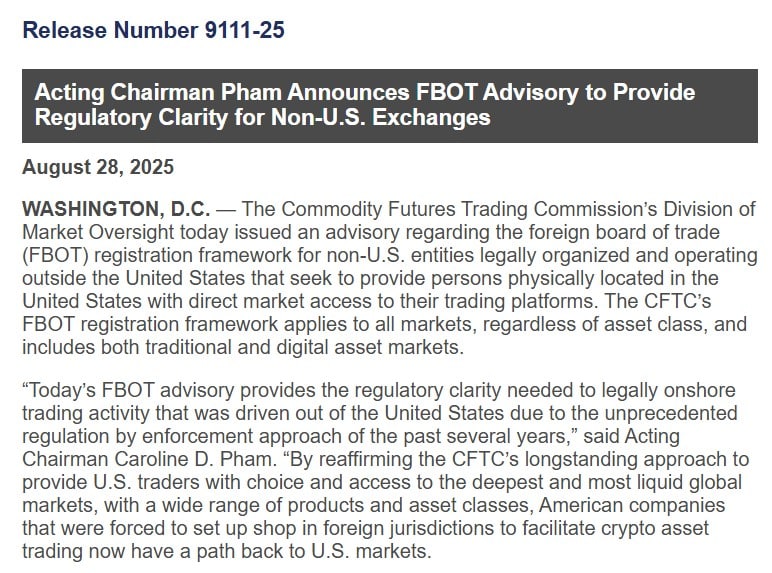The CFTC’s proposal to allow legal access to offshore crypto exchanges would let U.S. traders reconnect with global liquidity while bringing those platforms into U.S. oversight. This change, led by Acting Chair Caroline D. Pham, aims to onshore activity and reduce regulatory fragmentation.
-
CFTC to permit legal trading on offshore crypto exchanges for U.S. persons
-
Acting Chair Caroline D. Pham frames the move as a way to onshore trading and restore access to global liquidity.
-
Bitcoin ETFs post high volumes, but centralized exchanges like Binance still dominate spot trading.
Meta description: CFTC offshore exchanges plan could let U.S. traders trade on Binance and OKX again. Learn implications, volumes, and how traders may gain access.
What is the CFTC proposal to allow U.S. traders on offshore crypto exchanges?
The CFTC proposal would permit U.S. persons to legally access certain offshore crypto exchanges under clarified regulatory guidance. Acting Chair Caroline D. Pham says the change is intended to “onshore” trading activity that moved abroad and to provide a clear compliance path for firms and traders.
How would allowing offshore crypto exchanges affect market liquidity and access?
Allowing U.S. traders to access offshore crypto exchanges could restore direct access to deeper liquidity pools for assets like Bitcoin and Ethereum.
Exchanges such as Binance and OKX consistently report higher spot volumes than U.S. ETFs, and re-enabling legal access may narrow the gap between institutional ETF trading and retail exchange activity.
Why is the timing important?
Timing matters because U.S.-listed Bitcoin ETFs are generating record flows—$5–10 billion in daily volume on busy days—yet centralized exchanges continue to clear larger spot volumes.
Pham’s announcement follows recent staffing changes at the CFTC and comes as the agency seeks a regulatory approach that emphasizes clarity over enforcement-only tactics.
CFTC moves to open offshore exchanges to U.S. traders
The CFTC announced plans to let U.S. citizens legally trade crypto on offshore exchanges such as Binance, Bybit, and OKX under a clarified framework called the FBOT advisory.
The advisory aims to give firms a compliance pathway to bring offshore trading activity back into a U.S. regulatory framework and reduce the incentives that pushed trading abroad.
What did Acting Chair Caroline D. Pham say?
Pham described the advisory as providing the “regulatory clarity needed to legally onshore trading activity that was driven out of the United States due to the unprecedented regulation by enforcement approach of the past several years.”
She added that American companies that moved overseas to facilitate crypto trading now have a path back to U.S. markets.
How does current CFTC staffing affect this initiative?
Pham is presently the only Commissioner at the CFTC after a recent resignation, giving her broad discretion to advance novel measures quickly.
That singular leadership, combined with potential upcoming appointments, creates a narrow window for rapid policy moves before a full commission returns.


Source: cftc.gov
How do ETFs compare with exchanges today?
ETFs have grown quickly: U.S.-based Bitcoin ETFs can generate $5–10 billion in daily volume on busy days.
Despite that, centralized exchanges routinely exceed ETF volumes—Binance has reported peak BTC volumes up to $18 billion and ETH volumes above $11 billion.
Market-share snapshots show Binance commanding roughly 35% of ETH spot trading while ETFs account for a much smaller share (about 4% in some measures).
Frequently Asked Questions
Can U.S. retail traders immediately use offshore exchanges under the new guidance?
Not immediately. The FBOT advisory clarifies a compliance path but implementation will require exchange-level compliance steps and possibly additional staff guidance from the CFTC.
Will the CFTC regulate offshore platforms directly?
The CFTC aims to bring offshore trading activity under U.S. oversight by enabling compliant participation rather than unilateral direct regulation of foreign platforms.
What risks should traders consider?
Traders should weigh counterparty, custody, and compliance risks. Legal access does not remove market or operational risks that vary by platform and jurisdiction.
Key Takeaways
- CFTC policy shift: The agency is moving to create a legal path for U.S. persons to access offshore crypto exchanges.
- Market impact: Reopened access could reconnect U.S. traders to global liquidity and reduce fragmentation.
- Next steps: Exchanges and market participants must demonstrate compliance and await further CFTC guidance for concrete implementation.
Conclusion
The CFTC’s proposal to allow U.S. traders on offshore crypto exchanges could reshape market access and liquidity. Acting Chair Caroline D. Pham frames the effort as an onshoring strategy that balances access with oversight. Market participants should watch upcoming compliance guidance and platform announcements for implementation timelines.
